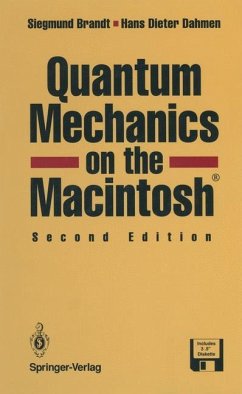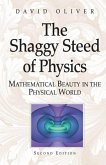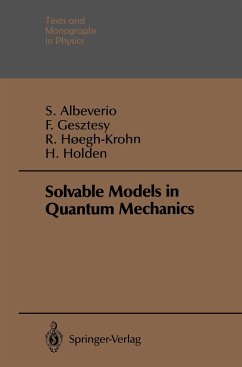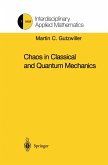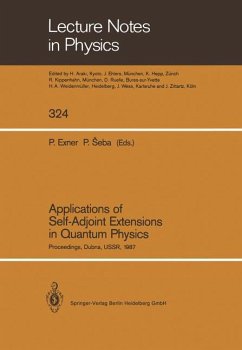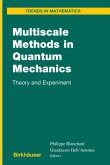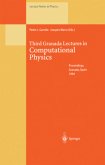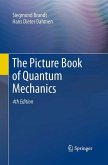- Broschiertes Buch
- Merkliste
- Auf die Merkliste
- Bewerten Bewerten
- Teilen
- Produkt teilen
- Produkterinnerung
- Produkterinnerung
Based on the interactive program Interquanta, Quantum Mechanics on the Macintosh, uses extensive 3-D graphics to guide the student through computer experiments in the quantum mechanics of free particle motion, bound states and scattering, tunneling, two-particle interactions, and more. It also includes a section on special functions of mathematical physics. With more than 200 problems, the text and programs provide students with practical experiences in using such hard-to-visualize concepts as complex amplitudes, eigenvalues, and scattering cross sections. The diskette included with the book…mehr
Andere Kunden interessierten sich auch für
![The Shaggy Steed of Physics The Shaggy Steed of Physics]() David OliverThe Shaggy Steed of Physics35,99 €
David OliverThe Shaggy Steed of Physics35,99 €![Solvable Models in Quantum Mechanics Solvable Models in Quantum Mechanics]() Sergio AlbeverioSolvable Models in Quantum Mechanics89,99 €
Sergio AlbeverioSolvable Models in Quantum Mechanics89,99 €![Chaos in Classical and Quantum Mechanics Chaos in Classical and Quantum Mechanics]() Martin C. GutzwillerChaos in Classical and Quantum Mechanics91,99 €
Martin C. GutzwillerChaos in Classical and Quantum Mechanics91,99 €![Applications of Self-Adjoint Extensions in Quantum Physics Applications of Self-Adjoint Extensions in Quantum Physics]() Applications of Self-Adjoint Extensions in Quantum Physics41,99 €
Applications of Self-Adjoint Extensions in Quantum Physics41,99 €![Multiscale Methods in Quantum Mechanics Multiscale Methods in Quantum Mechanics]() Multiscale Methods in Quantum Mechanics116,99 €
Multiscale Methods in Quantum Mechanics116,99 €![Third Granada Lectures in Computational Physics Third Granada Lectures in Computational Physics]() Third Granada Lectures in Computational Physics77,99 €
Third Granada Lectures in Computational Physics77,99 €![The Picture Book of Quantum Mechanics The Picture Book of Quantum Mechanics]() Siegmund BrandtThe Picture Book of Quantum Mechanics44,99 €
Siegmund BrandtThe Picture Book of Quantum Mechanics44,99 €-
-
-
Based on the interactive program Interquanta, Quantum Mechanics on the Macintosh, uses extensive 3-D graphics to guide the student through computer experiments in the quantum mechanics of free particle motion, bound states and scattering, tunneling, two-particle interactions, and more. It also includes a section on special functions of mathematical physics. With more than 200 problems, the text and programs provide students with practical experiences in using such hard-to-visualize concepts as complex amplitudes, eigenvalues, and scattering cross sections. The diskette included with the book provides two versions of the programs, one for use in computers with a mathematical coprocessor, the other optimized for machines without a coprocessor. For this new edition the software has been updated and extended.
Hinweis: Dieser Artikel kann nur an eine deutsche Lieferadresse ausgeliefert werden.
Hinweis: Dieser Artikel kann nur an eine deutsche Lieferadresse ausgeliefert werden.
Produktdetails
- Produktdetails
- Verlag: Springer / Springer New York / Springer, Berlin
- Artikelnr. des Verlages: 978-1-4612-7561-9
- 2. Aufl.
- Seitenzahl: 320
- Erscheinungstermin: 24. Februar 2014
- Englisch
- Abmessung: 235mm x 155mm x 18mm
- Gewicht: 487g
- ISBN-13: 9781461275619
- ISBN-10: 146127561X
- Artikelnr.: 41326070
- Herstellerkennzeichnung Die Herstellerinformationen sind derzeit nicht verfügbar.
- Verlag: Springer / Springer New York / Springer, Berlin
- Artikelnr. des Verlages: 978-1-4612-7561-9
- 2. Aufl.
- Seitenzahl: 320
- Erscheinungstermin: 24. Februar 2014
- Englisch
- Abmessung: 235mm x 155mm x 18mm
- Gewicht: 487g
- ISBN-13: 9781461275619
- ISBN-10: 146127561X
- Artikelnr.: 41326070
- Herstellerkennzeichnung Die Herstellerinformationen sind derzeit nicht verfügbar.
Quantum Mechanics on the Macintosh uses extensive 3-D graphics and more than 200 problems to guide the student through computer experiments in the quantum mechanics of free particle motion, bound states and scattering, tunneling, two-particle interactions, and more. The diskette included with the book provides programs in versions optimized for computers with or without mathematical coprocessors.
1 Introduction.- 1.1 Interquanta.- 1.2 The Structure of this Book.- 1.3 The Computer Laboratory.- 1.4 The Classroom Demonstrations.- 1.5 Literature.- 2 Free Particle Motion in One Dimension.- 2.1 Physical Concepts.- 2.2 A First Session with the Computer.- 2.3 The Time Development of a Gaussian Wave Packet.- 2.4 The Spectral Function of a Gaussian Wave Packet.- 2.5 The Wave Packet as a Sum of Harmonic Waves.- 2.6 Exercises.- 3 Bound States in One Dimension.- 3.1 Physical Concepts.- 3.2 Eigenstates in the Infinitely Deep Square-Well Potential and in the Harmonic-Oscillator Potential.- 3.3 Eigenstates in the Step Potential.- 3.4 Harmonic Particle Motion.- 3.5 Particle Motion in the Infinitely Deep Square-Well Potential.- 3.6 Exercises.- 4 Scattering in One Dimension.- 4.1 Physical Concepts.- 4.2 Stationary Scattering States in the Step Potential.- 4.3 Scattering of a Harmonic Wave by the Step Potential.- 4.4 Scattering of a Wave Packet by the Step Potential.- 4.5 Transmission and Reflection. The Argand Diagram.- 4.6 Exercises.- 4.7 Analogies in Optics.- 4.8 Reflection and Refraction of Stationary Electromagnetic Waves.- 4.9 Reflection and Refraction of a Harmonic Light Wave.- 4.10 Scattering of a Wave Packet of Light.- 4.11 Transmission, Reflection and Argand Diagram for a Light Wave.- 4.12 Exercises.- 5 A Two-Particle System: Coupled Harmonic Oscillators.- 5.1 Physical Concepts.- 5.2 Stationary States.- 5.3 Time Dependence of Global Quantities.- 5.4 Joint Probability Densities.- 5.5 Marginal Distributions.- 5.6 Exercises.- 6 Free Particle Motion in Three Dimensions.- 6.1 Physical Concepts.- 6.2 The 3D Harmonic Plane Wave.- 6.3 The Plane Wave Decomposed into Spherical Waves.- 6.4 The 3D Gaussian Wave Packet.- 6.5 The Probability Ellipsoid.- 6.6 Angular-Momentum Decomposition of a Wave Packet.- 6.7 Exercises.- 7 Bound States in Three Dimensions.- 7.1 Physical Concepts.- 7.2 Radial Wave Functions in Simple Potentials.- 7.3 Radial Wave Functions in the Step Potential.- 7.4 Probability Densities.- 7.5 Harmonic Particle Motion.- 7.6 Exercises.- 8 Scattering in Three Dimensions.- 8.1 Physical Concepts.- 8.2 Radial Wave Functions.- 8.3 Stationary Wave Functions and Scattered Waves.- 8.4 Differential Cross Sections.- 8.5 Scattering Amplitude. Phase Shift. Partial and Total Cross Sections.- 8.6 Exercises.- 9 Special Functions of Mathematical Physics.- 9.1 Basic Formulae.- 9.2 Hermite Polynomials.- 9.3 Eigenfunctions of the One-Dimensional Harmonic Oscillator.- 9.4 Legendre Polynomials and Associated Legendre Functions.- 9.5 Spherical Harmonics.- 9.6 Bessel Functions.- 9.7 Spherical Bessel Functions.- 9.8 Laguerre Polynomials.- 9.9 Radial Eigenfunctions of the Harmonic Oscillator.- 9.10 Radial Eigenfunctions of the Hydrogen Atom.- 9.11 Simple Functions of a Complex Variable.- 9.12 Exercises.- 10. Additional Material and Hints for the Solution of Exercises.- 10.1 Units and Orders of Magnitude.- 10.2 Argand Diagrams and Unitarity for One-Dimensional Problems.- 10.3 Hints and Answers to the Exercises.- Appendix A. A Systematic Guide to IQ.- A.1 Dialog Between the User and IQ.- A.1.1 A Simple Example.- A.1.2 The General Form of Commands.- A.1.3 The Descriptor File.- A.1.4 The Descriptor (Record).- A.1.5 The PLOT Command.- A.1.6 The STOP Command.- A.1.7 HELP: The Commands HE and PH.- A.2 Coordinate Systems and Transformations.- A.2.1 The Different Coordinate Systems.- A.2.2 Defining the Transformations.- A.3 The Different Types of Plot.- A.3.1 Choosing a Plot Type: The Command CH.- A.3.2 Cartesian 3D Plots (Type 0 Plots).- A.3.3 Polar 3D Plots (Type 1Plots).- A.3.4 2D Plots (Type 2 Plots).- A.3.5 3D Column Plots (Type 3 Plots).- A.3.6 Special 3D Plots (Type 10 Plots).- A.4 The Background in the Plots.- A.4.1 Boxes and Coordinate Axes: The Command BO.- A.4.2 Scales.- A.4.3 Arrows.- A.4.4 Text and Numbers.- A.4.5 Mathematical Symbols and Formulae.- A.5 Further Commands.- A.5.1 Line Styles.- A.5.2 Multiple Plots.- A.5.3 Combined Plots.- A.5.4 Using Different Plotting Devices.- A.5.5 The Different Running Modes.- A.5.6 Introducing Physical Variables: The Commands VO toV9.- A.5.7 Reserved Commands.- Appendix B. How to Install IQ.- B.1 Hardware and Operating-System Requirements.- B.2 Diskette Format.- B.3 Installation on a Macintosh with Hard Disk.- B.4 Installation on a Macintosh without Hard Disk.- B.5 Limited Memory.- B.6 Removing Output Files.- Appendix C. Lists of All Provided Files.- C.1 Program File.- C.2 Data File Specifying Graphics Devices.- C.3 File Containing Fonts Used in Graphics.- C.4 Descriptor Files for Examples and Exercises.- C.5 Command Input Files and Associated Descriptor Files for Demonstrations.- C.6 Help Files.- Appendix D. Graphics Devices and Metafiles.- Index of IQ Commands.
1 Introduction.- 1.1 Interquanta.- 1.2 The Structure of this Book.- 1.3 The Computer Laboratory.- 1.4 The Classroom Demonstrations.- 1.5 Literature.- 2 Free Particle Motion in One Dimension.- 2.1 Physical Concepts.- 2.2 A First Session with the Computer.- 2.3 The Time Development of a Gaussian Wave Packet.- 2.4 The Spectral Function of a Gaussian Wave Packet.- 2.5 The Wave Packet as a Sum of Harmonic Waves.- 2.6 Exercises.- 3 Bound States in One Dimension.- 3.1 Physical Concepts.- 3.2 Eigenstates in the Infinitely Deep Square-Well Potential and in the Harmonic-Oscillator Potential.- 3.3 Eigenstates in the Step Potential.- 3.4 Harmonic Particle Motion.- 3.5 Particle Motion in the Infinitely Deep Square-Well Potential.- 3.6 Exercises.- 4 Scattering in One Dimension.- 4.1 Physical Concepts.- 4.2 Stationary Scattering States in the Step Potential.- 4.3 Scattering of a Harmonic Wave by the Step Potential.- 4.4 Scattering of a Wave Packet by the Step Potential.- 4.5 Transmission and Reflection. The Argand Diagram.- 4.6 Exercises.- 4.7 Analogies in Optics.- 4.8 Reflection and Refraction of Stationary Electromagnetic Waves.- 4.9 Reflection and Refraction of a Harmonic Light Wave.- 4.10 Scattering of a Wave Packet of Light.- 4.11 Transmission, Reflection and Argand Diagram for a Light Wave.- 4.12 Exercises.- 5 A Two-Particle System: Coupled Harmonic Oscillators.- 5.1 Physical Concepts.- 5.2 Stationary States.- 5.3 Time Dependence of Global Quantities.- 5.4 Joint Probability Densities.- 5.5 Marginal Distributions.- 5.6 Exercises.- 6 Free Particle Motion in Three Dimensions.- 6.1 Physical Concepts.- 6.2 The 3D Harmonic Plane Wave.- 6.3 The Plane Wave Decomposed into Spherical Waves.- 6.4 The 3D Gaussian Wave Packet.- 6.5 The Probability Ellipsoid.- 6.6 Angular-Momentum Decomposition of a Wave Packet.- 6.7 Exercises.- 7 Bound States in Three Dimensions.- 7.1 Physical Concepts.- 7.2 Radial Wave Functions in Simple Potentials.- 7.3 Radial Wave Functions in the Step Potential.- 7.4 Probability Densities.- 7.5 Harmonic Particle Motion.- 7.6 Exercises.- 8 Scattering in Three Dimensions.- 8.1 Physical Concepts.- 8.2 Radial Wave Functions.- 8.3 Stationary Wave Functions and Scattered Waves.- 8.4 Differential Cross Sections.- 8.5 Scattering Amplitude. Phase Shift. Partial and Total Cross Sections.- 8.6 Exercises.- 9 Special Functions of Mathematical Physics.- 9.1 Basic Formulae.- 9.2 Hermite Polynomials.- 9.3 Eigenfunctions of the One-Dimensional Harmonic Oscillator.- 9.4 Legendre Polynomials and Associated Legendre Functions.- 9.5 Spherical Harmonics.- 9.6 Bessel Functions.- 9.7 Spherical Bessel Functions.- 9.8 Laguerre Polynomials.- 9.9 Radial Eigenfunctions of the Harmonic Oscillator.- 9.10 Radial Eigenfunctions of the Hydrogen Atom.- 9.11 Simple Functions of a Complex Variable.- 9.12 Exercises.- 10. Additional Material and Hints for the Solution of Exercises.- 10.1 Units and Orders of Magnitude.- 10.2 Argand Diagrams and Unitarity for One-Dimensional Problems.- 10.3 Hints and Answers to the Exercises.- Appendix A. A Systematic Guide to IQ.- A.1 Dialog Between the User and IQ.- A.1.1 A Simple Example.- A.1.2 The General Form of Commands.- A.1.3 The Descriptor File.- A.1.4 The Descriptor (Record).- A.1.5 The PLOT Command.- A.1.6 The STOP Command.- A.1.7 HELP: The Commands HE and PH.- A.2 Coordinate Systems and Transformations.- A.2.1 The Different Coordinate Systems.- A.2.2 Defining the Transformations.- A.3 The Different Types of Plot.- A.3.1 Choosing a Plot Type: The Command CH.- A.3.2 Cartesian 3D Plots (Type 0 Plots).- A.3.3 Polar 3D Plots (Type 1Plots).- A.3.4 2D Plots (Type 2 Plots).- A.3.5 3D Column Plots (Type 3 Plots).- A.3.6 Special 3D Plots (Type 10 Plots).- A.4 The Background in the Plots.- A.4.1 Boxes and Coordinate Axes: The Command BO.- A.4.2 Scales.- A.4.3 Arrows.- A.4.4 Text and Numbers.- A.4.5 Mathematical Symbols and Formulae.- A.5 Further Commands.- A.5.1 Line Styles.- A.5.2 Multiple Plots.- A.5.3 Combined Plots.- A.5.4 Using Different Plotting Devices.- A.5.5 The Different Running Modes.- A.5.6 Introducing Physical Variables: The Commands VO toV9.- A.5.7 Reserved Commands.- Appendix B. How to Install IQ.- B.1 Hardware and Operating-System Requirements.- B.2 Diskette Format.- B.3 Installation on a Macintosh with Hard Disk.- B.4 Installation on a Macintosh without Hard Disk.- B.5 Limited Memory.- B.6 Removing Output Files.- Appendix C. Lists of All Provided Files.- C.1 Program File.- C.2 Data File Specifying Graphics Devices.- C.3 File Containing Fonts Used in Graphics.- C.4 Descriptor Files for Examples and Exercises.- C.5 Command Input Files and Associated Descriptor Files for Demonstrations.- C.6 Help Files.- Appendix D. Graphics Devices and Metafiles.- Index of IQ Commands.

